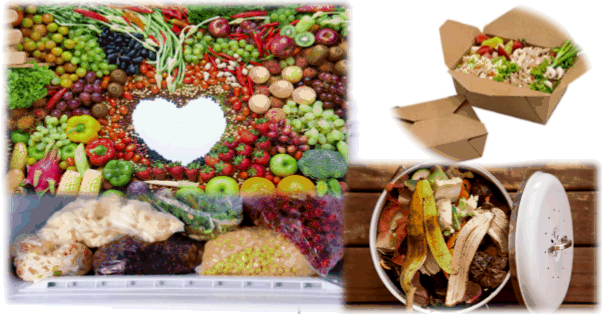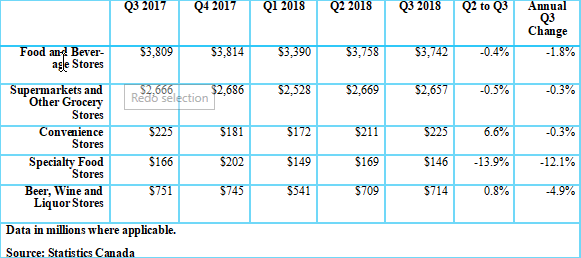| |
Food Trends for 2019
As we make our way into 2019, it is the time of year to look at food trends for the year ahead. These have been taken from a variety of sources. They are by no means all of the trends named by chefs, food writers and other industry experts. The ones highlighted appeared on multiple lists that could be grouped into themes, or were interesting trends, but all were relevant to Alberta companies. Thus no seaweed, marine creatures or other products that are difficult to raise, grow or make in the prairies are included.

Resurgence of Frozen: The frozen aisle has become more appealing to consumers due to an expansion in the quality of products. The selection is wider than just a three vegetable medley or a “TV dinner” of old, current products capture all manner of prepared foods. Consumers are realizing that frozen is not just convenient, it can also be healthy. Freezing allows for the retention of nutrients after harvest.
Plant Based Foods: Plants are moving from the side of the plate to become the main dish. In Sterling-Rice Group’s Culinary Trends 2019, they call it “Rooted and Ravishing”. Root vegetables such as parsnips, yams, potatoes, etc., are not the only plants to be seen as part of this trend. Mushrooms are thought to be the next superfood on the horizon. They have been a main dish protein substitute for a while but are now becoming a snack as well. Mushroom based ‘faux meat” snacks are offering consumers a taste and texture alternative. Seeds are also getting into this development. Seed butters from pumpkin or sunflower seeds are a protein rich source of unsaturated fat. This does not even cover the uses being found for pea or legume protein products.
Food waste: The industry is looking for ways to reduce the amount of food waste generated. Grocers selling and chefs are finding uses for “ugly produce”, vegetables that are not uniform or aesthetically pleasing for conventional retail. Consumers are becoming more aware of how that perfect standard is wasting food and the associated environmental resources. Retailers are getting clever about selling “carrot men” with multiple limbs. Chef are offering up recipes and cookbooks not only for slightly overripe fruits but also left overs. Yogurtlab labels this trend “Food Recovery”. The industry is also looking at better ways to either extend a product’s shelf life or have more accurate “best before” dates.
Eco-conscious packaging: Companies are exploring ways to reduce the amount of packaging surrounding their products. This trend can be seen in the elimination of single straws in many restaurants. This is also being extended to other product packaging as non-plastic and even edible options are tested. Some firms, especially produce departments are testing BYOVB (bring your own vegetable bag), where consumers bringing their own bag for their fresh fruits and vegetables. These trends and many others projected for the next year can be very helpful to an Alberta producer, processor, restaurateur or retailer. They can help to inform product, packaging and marketing decisions in the next year and beyond.
Grocery E-Commerce in Canada

Although e-commerce currently represents a small portion of food retail sales in Canada (1.5 per cent), it has growth potential and some significant implications for the industry. Sylvain Charlebois estimates that it could rise to seven per cent in the next decade given how connected the country is. That would equate to almost $10 billion in sales or the equivalent of 800 “decent size” stores. Other countries such as Ireland the United Kingdom are already at 7.5 per cent. Another source, IGD projects that the online grocery markets in Canada will reach 2.1 billion by 2023. The growth will be driven by “rapidly evolving shopper expectations and exciting tech innovations”.
In Canada, many grocers are offering home delivery options in order to supplement their ecommerce and capitalize upon this trend. Walmart Canada is expanding its “click and collect” to 22 locations in Victoria, Regina, Quebec City and Halifax, adding to existing locations in Ontario, Quebec, Alberta, BC and Manitoba. They are investing $175 million to renovate their stores in order to better blend the online and in-store shopping experience to increase the ease of shopping. They are also partnering with Food-X Urban Delivery to explore home delivery in Vancouver and Instacart in Toronto for one hour delivery. Loblaw’s has also partnered with Instacart to provide quick delivery times. Sobeys has entered a partnership with Ocado Group to build a “customer fulfillment center” in Toronto. While 17 per cent of consumers shop for their groceries online, they still shop at a physical store more than six times in a month. Bricks and mortar stores should not necessarily take this with comfort but more as a sign of things to come. It is expected that over time, more of the grocery dollar will move on-line.
The online shopper is more thoughtful and strategic. They are less impulsive than an in store shopper who can be swayed by the point-of -purchase displays and other enticements to buy more. The opportunities to increase purchases or upsell are not as readily available. In fact, the online shopper does not like to be inundated with upsell suggestions or irrelevant product recommendations. A recent survey from Retail Council of Canada showed that “experiencing a problem purchasing” is the top complaint (55 per cent), so having reliable tech is the key. However, once they find an online retailer they trust, the on-line consumer will stick with them.
For retailers, personalizing the experience to make pricing, promotions and communications relevant is a key concern. With grocery, it is also important to “get over the trust barrier”. While consumers generally have no issue with non-perishable products being purchased online, fresh products will take some convincing. Shoppers are used to touching and smelling fresh produce to establish quality. Many on-line retailers start with non-food items, then shelf stable items to gain the consumers’ trust about quality, reliability and quick delivery. Suggesting relevant promotions and enticing offers to purchase fresh produce once this trust is establish will in all likelihood make the customer more willing to take a chance on fresh.
Data Highlights
Overall, food and beverage sales in Alberta showed a slight decline of almost two per cent annually. While year over year change is slightly negative for all sub categories, specialty food stores had the largest percentage decline from 2017, with a 12.1 per cent decline. Not surprising given that the category also had a - 13.9 per cent change from second to third quarter of 2018 (the summer into fall transition). Convenience stores had the largest positive change in the third quarter with a 6.6 per cent increase.
Food and Beverage Sales in Alberta

Sales at foodservice and drinking places have shown some growth for both reference periods. Growth in 2018 from second quarter to the third was four per cent. Year over year quarter three growth was two per cent.
Foodservice and Drinking Places Sales in Alberta

References
Food Trends:
Grocery E Commerce:
|
|